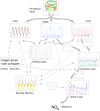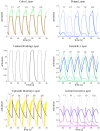Inhibition in the dynamics of selective attention: an integrative model for negative priming
- PMID: 23162523
- PMCID: PMC3498964
- DOI: 10.3389/fpsyg.2012.00491
Inhibition in the dynamics of selective attention: an integrative model for negative priming
Abstract
We introduce a computational model of the negative priming (NP) effect that includes perception, memory, attention, decision making, and action. The model is designed to provide a coherent picture across competing theories of NP. The model is formulated in terms of abstract dynamics for the activations of features, their binding into object entities, their semantic categorization as well as related memories and appropriate reactions. The dynamic variables interact in a connectionist network which is shown to be adaptable to a variety of experimental paradigms. We find that selective attention can be modeled by means of inhibitory processes and by a threshold dynamics. From the necessity of quantifying the experimental paradigms, we conclude that the specificity of the experimental paradigm must be taken into account when predicting the nature of the NP effect.
Keywords: computational modeling; connectionist models; negative priming; selective attention.
Figures







Similar articles
-
Computational modeling of the negative priming effect based on inhibition patterns and working memory.Front Comput Neurosci. 2013 Nov 19;7:166. doi: 10.3389/fncom.2013.00166. eCollection 2013. Front Comput Neurosci. 2013. PMID: 24312046 Free PMC article.
-
The negative priming paradigm: An update and implications for selective attention.Psychon Bull Rev. 2015 Dec;22(6):1577-97. doi: 10.3758/s13423-015-0841-4. Psychon Bull Rev. 2015. PMID: 25917144 Review.
-
[Inhibition and resource capacity during normal aging: a confrontation of the dorsal-ventral and frontal models in a modified version of negative priming].Encephale. 2006 Mar-Apr;32(2 Pt 1):253-62. doi: 10.1016/s0013-7006(06)76152-8. Encephale. 2006. PMID: 16910627 French.
-
Negative priming with numbers: no evidence for a semantic locus.Q J Exp Psychol A. 2005 Oct;58(7):1153-72. doi: 10.1080/02724980443000520. Q J Exp Psychol A. 2005. PMID: 16194953
-
[Schizophrenia and semantic priming effects].Encephale. 2006 Jan-Feb;32(1 Pt 1):75-82. doi: 10.1016/s0013-7006(06)76139-5. Encephale. 2006. PMID: 16633293 Review. French.
Cited by
-
When the ignored gets bound: sequential effects in the flanker task.Front Psychol. 2013 Jan 2;3:552. doi: 10.3389/fpsyg.2012.00552. eCollection 2012. Front Psychol. 2013. PMID: 23293616 Free PMC article.
-
Influence of Judo Experience on Neuroelectric Activity During a Selective Attention Task.Front Psychol. 2020 Jan 9;10:2838. doi: 10.3389/fpsyg.2019.02838. eCollection 2019. Front Psychol. 2020. PMID: 31993002 Free PMC article.
-
Altered inhibitory control and increased sensitivity to cross-modal interference in tinnitus during auditory and visual tasks.PLoS One. 2015 Mar 12;10(3):e0120387. doi: 10.1371/journal.pone.0120387. eCollection 2015. PLoS One. 2015. PMID: 25763867 Free PMC article.
-
Computational modeling of the negative priming effect based on inhibition patterns and working memory.Front Comput Neurosci. 2013 Nov 19;7:166. doi: 10.3389/fncom.2013.00166. eCollection 2013. Front Comput Neurosci. 2013. PMID: 24312046 Free PMC article.
-
The process of feature binding.Front Psychol. 2013 Apr 18;4:207. doi: 10.3389/fpsyg.2013.00207. eCollection 2013. Front Psychol. 2013. PMID: 23616781 Free PMC article. No abstract available.
References
-
- Allport D., Tipper S., Chmiel N. (1985). “Perceptual integration and post-categorical filtering,” in Attention Performance XI, eds Posner M. I., Marin O. S. M. (Hillsdale, NJ: Erlbaum; ), 107–132
-
- Anderson J., Matessa M., Lebiere C. (1997). ACT-R: a theory of higher level cognition and its relation to visual attention. Int. J. Hum. Comput. Interact. 12, 439–462
-
- Banks W., Roberts D., Ciranni M. (1995). Negative priming in auditory attention. J. Exp. Psychol. Hum. Percept. Perform. 21, 1354–136110.1037/0096-1523.21.6.1354 - DOI
-
- Barnard P. (1985). “Interactive cognitive subsystems: a psycholinguistic approach to short-term memory,” in Progress in the Psychology of Language, Vol. 2, Chap. 6, ed. Ellis A. (Hove: Lawrence Erlbaum Associates, Ltd; ), 197–258
LinkOut - more resources
Full Text Sources
Miscellaneous

